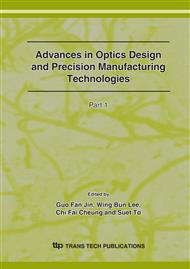p.992
p.998
p.1003
p.1009
p.1015
p.1021
p.1026
p.1032
p.1037
The Study of High Speed Turning of the Hardened Mold Steel SKD11 by Ceramic Cutting Tools
Abstract:
This study discusses the high speed turning of the hardened mold steel by ceramic cutting tools. From the experiments, we can understand the tool wear condition, tool failure mode and the surface roughness variation of the workpiece. In order to understand the tool wear and surface roughness characteristics during the high speed turning process of the hardened mold steel by ceramic cutting tools, the polynomial network was used to construct the tool wear and surface roughness prediction model. The polynomial network is constituted of several function nodes; these function nodes can be self-organizing into the optimal network structures according to the predicted square error (PSE) criteria. It is shown that the polynomial network can correctly correlate the input variables (cutting speed, feed rate and cutting time) with the output variables (tool wear and surface roughness). Based on the tool wear and surface roughness prediction model constructed, the wear amount of the ceramic cutting tools and the surface roughness of the workpiece can be predicted with reasonable accuracy if the turning conditions are given and it is also consistent with the experimental results very well. The manufacturing engineers can then , according to the prediction results, execute the process planning, decide the manufacturing process and the tool change time, thus preventing the cutting tool from being over-worn or failing when it is in use.
Info:
Periodical:
Pages:
1015-1020
Citation:
Online since:
December 2007
Authors:
Price:
Сopyright:
© 2008 Trans Tech Publications Ltd. All Rights Reserved
Share:
Citation:


